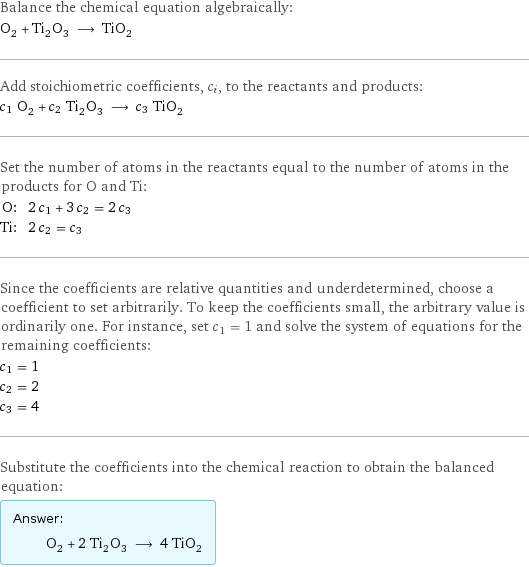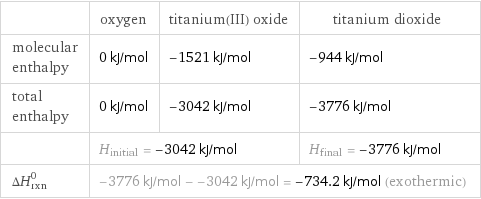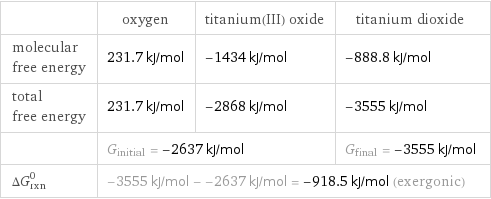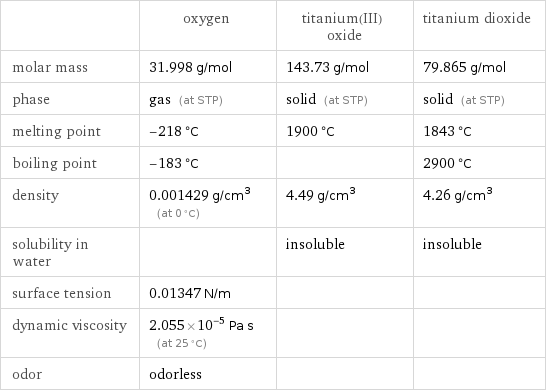Input interpretation

O_2 oxygen + Ti_2O_3 titanium(III) oxide ⟶ TiO_2 titanium dioxide
Balanced equation

Balance the chemical equation algebraically: O_2 + Ti_2O_3 ⟶ TiO_2 Add stoichiometric coefficients, c_i, to the reactants and products: c_1 O_2 + c_2 Ti_2O_3 ⟶ c_3 TiO_2 Set the number of atoms in the reactants equal to the number of atoms in the products for O and Ti: O: | 2 c_1 + 3 c_2 = 2 c_3 Ti: | 2 c_2 = c_3 Since the coefficients are relative quantities and underdetermined, choose a coefficient to set arbitrarily. To keep the coefficients small, the arbitrary value is ordinarily one. For instance, set c_1 = 1 and solve the system of equations for the remaining coefficients: c_1 = 1 c_2 = 2 c_3 = 4 Substitute the coefficients into the chemical reaction to obtain the balanced equation: Answer: | | O_2 + 2 Ti_2O_3 ⟶ 4 TiO_2
Structures

+ ⟶
Names

oxygen + titanium(III) oxide ⟶ titanium dioxide
Reaction thermodynamics
Enthalpy

| oxygen | titanium(III) oxide | titanium dioxide molecular enthalpy | 0 kJ/mol | -1521 kJ/mol | -944 kJ/mol total enthalpy | 0 kJ/mol | -3042 kJ/mol | -3776 kJ/mol | H_initial = -3042 kJ/mol | | H_final = -3776 kJ/mol ΔH_rxn^0 | -3776 kJ/mol - -3042 kJ/mol = -734.2 kJ/mol (exothermic) | |
Gibbs free energy

| oxygen | titanium(III) oxide | titanium dioxide molecular free energy | 231.7 kJ/mol | -1434 kJ/mol | -888.8 kJ/mol total free energy | 231.7 kJ/mol | -2868 kJ/mol | -3555 kJ/mol | G_initial = -2637 kJ/mol | | G_final = -3555 kJ/mol ΔG_rxn^0 | -3555 kJ/mol - -2637 kJ/mol = -918.5 kJ/mol (exergonic) | |
Equilibrium constant
![Construct the equilibrium constant, K, expression for: O_2 + Ti_2O_3 ⟶ TiO_2 Plan: • Balance the chemical equation. • Determine the stoichiometric numbers. • Assemble the activity expression for each chemical species. • Use the activity expressions to build the equilibrium constant expression. Write the balanced chemical equation: O_2 + 2 Ti_2O_3 ⟶ 4 TiO_2 Assign stoichiometric numbers, ν_i, using the stoichiometric coefficients, c_i, from the balanced chemical equation in the following manner: ν_i = -c_i for reactants and ν_i = c_i for products: chemical species | c_i | ν_i O_2 | 1 | -1 Ti_2O_3 | 2 | -2 TiO_2 | 4 | 4 Assemble the activity expressions accounting for the state of matter and ν_i: chemical species | c_i | ν_i | activity expression O_2 | 1 | -1 | ([O2])^(-1) Ti_2O_3 | 2 | -2 | ([Ti2O3])^(-2) TiO_2 | 4 | 4 | ([TiO2])^4 The equilibrium constant symbol in the concentration basis is: K_c Mulitply the activity expressions to arrive at the K_c expression: Answer: | | K_c = ([O2])^(-1) ([Ti2O3])^(-2) ([TiO2])^4 = ([TiO2])^4/([O2] ([Ti2O3])^2)](../image_source/847d3f9e03ce23c454f0471400665665.png)
Construct the equilibrium constant, K, expression for: O_2 + Ti_2O_3 ⟶ TiO_2 Plan: • Balance the chemical equation. • Determine the stoichiometric numbers. • Assemble the activity expression for each chemical species. • Use the activity expressions to build the equilibrium constant expression. Write the balanced chemical equation: O_2 + 2 Ti_2O_3 ⟶ 4 TiO_2 Assign stoichiometric numbers, ν_i, using the stoichiometric coefficients, c_i, from the balanced chemical equation in the following manner: ν_i = -c_i for reactants and ν_i = c_i for products: chemical species | c_i | ν_i O_2 | 1 | -1 Ti_2O_3 | 2 | -2 TiO_2 | 4 | 4 Assemble the activity expressions accounting for the state of matter and ν_i: chemical species | c_i | ν_i | activity expression O_2 | 1 | -1 | ([O2])^(-1) Ti_2O_3 | 2 | -2 | ([Ti2O3])^(-2) TiO_2 | 4 | 4 | ([TiO2])^4 The equilibrium constant symbol in the concentration basis is: K_c Mulitply the activity expressions to arrive at the K_c expression: Answer: | | K_c = ([O2])^(-1) ([Ti2O3])^(-2) ([TiO2])^4 = ([TiO2])^4/([O2] ([Ti2O3])^2)
Rate of reaction
![Construct the rate of reaction expression for: O_2 + Ti_2O_3 ⟶ TiO_2 Plan: • Balance the chemical equation. • Determine the stoichiometric numbers. • Assemble the rate term for each chemical species. • Write the rate of reaction expression. Write the balanced chemical equation: O_2 + 2 Ti_2O_3 ⟶ 4 TiO_2 Assign stoichiometric numbers, ν_i, using the stoichiometric coefficients, c_i, from the balanced chemical equation in the following manner: ν_i = -c_i for reactants and ν_i = c_i for products: chemical species | c_i | ν_i O_2 | 1 | -1 Ti_2O_3 | 2 | -2 TiO_2 | 4 | 4 The rate term for each chemical species, B_i, is 1/ν_i(Δ[B_i])/(Δt) where [B_i] is the amount concentration and t is time: chemical species | c_i | ν_i | rate term O_2 | 1 | -1 | -(Δ[O2])/(Δt) Ti_2O_3 | 2 | -2 | -1/2 (Δ[Ti2O3])/(Δt) TiO_2 | 4 | 4 | 1/4 (Δ[TiO2])/(Δt) (for infinitesimal rate of change, replace Δ with d) Set the rate terms equal to each other to arrive at the rate expression: Answer: | | rate = -(Δ[O2])/(Δt) = -1/2 (Δ[Ti2O3])/(Δt) = 1/4 (Δ[TiO2])/(Δt) (assuming constant volume and no accumulation of intermediates or side products)](../image_source/462a5204fef721a61eb37e5df27c3266.png)
Construct the rate of reaction expression for: O_2 + Ti_2O_3 ⟶ TiO_2 Plan: • Balance the chemical equation. • Determine the stoichiometric numbers. • Assemble the rate term for each chemical species. • Write the rate of reaction expression. Write the balanced chemical equation: O_2 + 2 Ti_2O_3 ⟶ 4 TiO_2 Assign stoichiometric numbers, ν_i, using the stoichiometric coefficients, c_i, from the balanced chemical equation in the following manner: ν_i = -c_i for reactants and ν_i = c_i for products: chemical species | c_i | ν_i O_2 | 1 | -1 Ti_2O_3 | 2 | -2 TiO_2 | 4 | 4 The rate term for each chemical species, B_i, is 1/ν_i(Δ[B_i])/(Δt) where [B_i] is the amount concentration and t is time: chemical species | c_i | ν_i | rate term O_2 | 1 | -1 | -(Δ[O2])/(Δt) Ti_2O_3 | 2 | -2 | -1/2 (Δ[Ti2O3])/(Δt) TiO_2 | 4 | 4 | 1/4 (Δ[TiO2])/(Δt) (for infinitesimal rate of change, replace Δ with d) Set the rate terms equal to each other to arrive at the rate expression: Answer: | | rate = -(Δ[O2])/(Δt) = -1/2 (Δ[Ti2O3])/(Δt) = 1/4 (Δ[TiO2])/(Δt) (assuming constant volume and no accumulation of intermediates or side products)
Chemical names and formulas

| oxygen | titanium(III) oxide | titanium dioxide formula | O_2 | Ti_2O_3 | TiO_2 Hill formula | O_2 | O_3Ti_2 | O_2Ti name | oxygen | titanium(III) oxide | titanium dioxide IUPAC name | molecular oxygen | |
Substance properties

| oxygen | titanium(III) oxide | titanium dioxide molar mass | 31.998 g/mol | 143.73 g/mol | 79.865 g/mol phase | gas (at STP) | solid (at STP) | solid (at STP) melting point | -218 °C | 1900 °C | 1843 °C boiling point | -183 °C | | 2900 °C density | 0.001429 g/cm^3 (at 0 °C) | 4.49 g/cm^3 | 4.26 g/cm^3 solubility in water | | insoluble | insoluble surface tension | 0.01347 N/m | | dynamic viscosity | 2.055×10^-5 Pa s (at 25 °C) | | odor | odorless | |
Units
